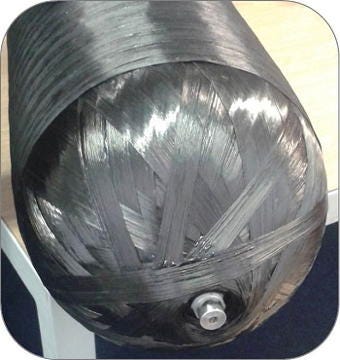Various companies have developed thermoplastic composite gas tanks for compressed natural gas- (CNG) powered vehicles including the likes of Gastank Sweden AB (Norrfjärden) with its zero-permeation cylinders that meet the very stringent ECE R110 regulation, and Covess (Berbroek, Belgium).
June 11, 2014
Various companies have developed thermoplastic composite gas tanks for compressed natural gas- (CNG) powered vehicles including the likes of Gastank Sweden AB (Norrfjärden) with its zero-permeation cylinders that meet the very stringent ECE R110 regulation, and Covess (Berbroek, Belgium). Both tank makers employ Akulon Fuel Lock polyamide (PA) 6 resin from DSM Engineering Plastics (Birmingham, MI) as the permeation barrier material. The next challenge on the agenda? Developing thermoplastic tanks for hydrogen storage in fuel cell vehicles.
At the recent NGV Global 2014 show in Long Beach, CA, Covess and DSM exhibited their latest offerings to the natural gas vehicle industry. According to the partners, hydrogen and natural gas are claiming their place in the field of cost-effective and low carbon footprint fuels for the automotive. Countries with major natural gas reserves are looking at the advantage of using CNG as an alternative fuel which reduces the CO2 emission by 15% compared to current solutions in petrol or diesel and is estimated to drive growth by some 25% in the coming years.
|
Covess and DSM have already developed thermoplastic composite gas tanks for compressed natural gas (CNG). |
A traditional steel tank of 40-liter capacity weighs around 60 kg. In comparison, a composite Type IV tank* employing an Akulon Fuel Lock liner and a newly developed DSM PA-based polymer with zero carbon footprint that has high creep and chemical resistance as the matrix material can weigh down to 20 kg if carbon fiber is used as the reinforcing material. For every 10 kg of weight reduction, a CO2 reduction of one gram per km - which enables manufacturers to avoid a penalty of €95 in EU.
Regulatory measures introduced in 2012 in the EU require 95% of all new cars sold in the EU emit no more than 95 grams of CO2 per kilometer on average in 2020, with 100% of new vehicles needing to comply in 2021. The current target for all new cars in the EU is 130 grams of CO2 per kilometer by 2015. Automakers that fail to comply are required to pay a per-car fine of €95 ($129) per g/km for every gram of CO2 over the target.
Another key ability of the Akulon Fuel Lock liner is to balance low temperature performance (down to -60°C) against a low permeation. The permeation of HDPE liners is reportedly too high to install composite Type IV tanks inside a vehicle. However, Akulon Fuel Lock liner material reduces the emission by at least a factor of 150 compared to HDPE and therefore enables the use of Type IV tanks inside the car.
The lifetime of these thermoplastic tanks also reportedly exceeds conventional steel or even advanced thermoset gas tanks due to the unique concept of consolidating the continuous glass fiber and/or carbon fiber and the PA matrix, which imparts high fatigue performance. The tank production process itself is patented by Covess and partially confidential.
"The key difference between CNG tanks and the hydrogen tanks is thickness, because of the higher required pressure," says Tim Vorage, Global Incubator Manager at DSM Engineering Plastics. "Higher pressure requires higher strength."
The tanks can also be 100% recycled in prime applications, thereby closing the end-of-life cycle. "The entire tank can be regrinded and reworked into prime automotive applications," says Tim Vorage, Global Incubator Manager at DSM Engineering Plastics.
While automakers chasing emission targets may opt for lighter carbon fiber, "glass fiber may be employed when relative costs are a more important factor, for example after market passenger cars or even sometimes for gas transportation vessels," says Vorage. A combination of the two fiber types may also be used.
Another active player in the CNG tank arena is 3M, which launched its first CNG tank in 2013, incorporating nanoparticle-enhanced resin technology in order to engineer tanks that are up to 30% lighter and have up to 10% more storage capacity than the market leading Type IV alternative. 3M has teamed up with Rush Enterprises, a service provider to the commercial vehicle industry that owns and operates the largest network of commercial vehicle dealerships in the United States, to further market penetration of its technology. The agreement between the firms allows for 3M to supply tanks with its proprietary technology, and for Rush Enterprises to provide enhanced fuel systems, distribution and service support.
"We believe the lack of a holistic approach to fuel system development has slowed adoption in this segment," said Rory Yanchek, Vice President and General Manager for 3M's Aerospace & Commercial Transportation Division. "Our collaboration with Rush Enterprises will help accelerate industry adoption by bringing superior value to customers, and delivering quality solutions that address many currently unmet needs."
Yanchek continued, "Industry partnerships can address these needs, but they must be built on a foundation of technology, a relentless commitment to quality, and aftermarket support."
"By pairing a leading materials/technology company with one of the largest commercial vehicle dealership networks, we hope to achieve scale as well as move the needle in customer service and innovation," said Mr. Rush. "Working with 3M on a new fuel system and incorporating a diversity of 3M's proprietary materials to enhance value, as well as leveraging 3M's expertise in Lean Six Sigma manufacturing processes, is going to improve the overall quality and reliability we bring to customers."
*Composite tank manufactured from a carbon fiber composite with a polymer liner.
You May Also Like



